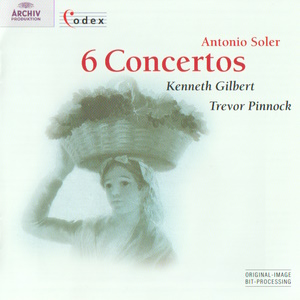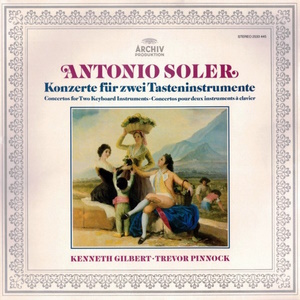 |
|
1 CD -
453 171-2 - (p) 1996
|
|
50
Jahre (1947-1997) - Codex I Serie - 10/10
|
|
|
|
|
|
|
|
SIX CONCERTOS FOR
TWO KEYBOARD INSTRUMENTS
|
|
|
|
|
|
|
|
Antonio
SOLER ( 1729-1783)
|
Concerto
no. 1 in C major |
|
10' 33" |
|
|
-
Andante
|
5' 26" |
|
1 |
|
-
Minué
|
5' 07" |
|
2 |
|
Concerto
no. 5 in A major |
|
9' 31" |
|
|
-
Cantabile |
3' 59" |
|
3 |
|
-
Minué
|
5' 32" |
|
4 |
|
Concerto
no. 3 in G major
|
|
11' 30" |
|
|
-
Andantino |
5' 49" |
|
5 |
|
-
Minué |
5' 41" |
|
6 |
|
Concerto
no. 4 in F major |
|
9' 04" |
|
|
-
Afectuoso - Andante non Largo
|
4' 11" |
|
7 |
|
-
Minué
|
4' 53" |
|
8 |
|
Concerto
no. 2 in A minor |
|
13' 06" |
|
|
-
Andante
|
4' 22" |
|
9 |
|
-
Allegro
|
3' 26" |
|
10 |
|
-
Tempo de Minué |
5' 18" |
|
11 |
|
Concerto
no. 6 in D major |
|
10' 47" |
|
|
-
Allegro - Andante - Allegro -
Andante
|
4' 15" |
|
12 |
|
-
Minué |
6' 32" |
|
13 |
|
|
|
|
Kenneth GILBERT
Trevor PINNOCK
Concertos 1, 3, 4 & 6 on two
harpsichords
Concertos 2 & 5 on two fortepianos
|
The instruments:
Harpsichords:
- Clayson & Garrett Lyminge,
Folkesonte, 1978 & 1979, after
Vincenzio Sodi, Florence, 1782
Fortepiano:
- Adlam Burnett Workshop, Finchcocks,
Goudhurst, Kent, 1974 & 1977,
after Matthaeus Heilmann, Mainz, c.
1785
Pitch: a' = 440 Hz
Publishers: B. Schott's Söhne,
Mainz 1972, ed. M. S. Kastner (ED
6230)
|
|
|
|
|
Luogo
e data di registrazione |
|
Henry
Wood Hall, London (Inghilterra) -
26-28 maggio 1979
|
|
|
Original
Editions |
|
Archiv
Produktion | 2533 445 | 1 LP | (p)
1980 | ANA
|
|
|
Edizione
"Codex"
|
|
Archiv
Produktion "Codex" | 453 171-2 |
durata 64' 55" | LC 0113 | 1 CD |
(p) 1996 | ADD | stereo
|
|
|
Executive
Producer |
|
Dr.
Andreas Holschneider
|
|
|
Recording
Producer and Tonmeister |
|
Heinz
Wildhagen
|
|
|
Recording
Engineer |
|
Joachim
Niss
|
|
|
Cover |
|
Francisco
de Goya "La Vendimia - El Otono"
(detail), Museo del Prado
|
|
|
Art Direction
|
|
Fred
Münzmaier
|
|
|
Note |
|
Original-Image-Bit-Processing
- Added presence and brilliance,
greater spatial definition |
|
|
|
|
|
ORIGINAL
EDITIONS

1 LP - 2533 445 - (p) 1980
|
Treasures
from Archiv Produktion’s
Catalogue
A rare and valuable collection of
documents is the pride of any
library or archive. CODEX, Archiv
Produktion’s new series, presents
rare documents in sound from 50
years of pioneering recording.
These recordings have been
digitally remastered using
original-image bit-processing
technology and can now be
appreciated in all the richness of
their original sound-image. They
range from the serene counterpoint
of a Machaut, the intensely
spiritual polyphony of a Victoria,
to the imposing state-music of a
Handel.
For the artists on Archiv
Produktion recordings, a constant
aim has been to rediscover the
musical pulse of past times and to
recreate the spirit of past ages.
In this sense each performance
here - whether by Pro Musica
Antiqua of Brussels in the 1950s,
the Regensburg Domchor in the
1960s, or Kenneth Gilbert and
Trevor Pinnock in the 1970s - made
a vital contribution to the
revival of Early Music in our
time.
CODEX highlights recordings that
were unique in their day, many of
them first recordings ever of this
rare and remarkable repertoire,
now appearing for the first time on
CD. A special aspect of the
history of performance in our
century can now be revisited, as
great moments from Archiv
Produktion’s recording history are
restored and experienced afresh.
Dr.
Peter Czornyi
Director,
Archiv Produktion
SOLER: SIX CONCERTOS FOR TWO
KEYBOARD INSTRUMENTS
Antonio Soler was born at the
beginning of December 1729 at Olot
de Porrera, a Catalan village in
the province of Gerona, and died
on 20 December 1783 in the
monastery of San Lorenzo del
Escorial. The exact date of his
birth is unknown, but he is known
to have been baptized on 3
December 1729. It was in this same
year that Domenico Scarlatti was
installed at the court of Spain.
At the age of six, Soler, son of a
musician of the Numancia regiment,
entered the choir-school of the
Benedictine monastery of
Montserrat. This great place of
pilgrimage, situated near
Barcelona, possessed one of the
most famous music schools of
Spain. There Soler received his
musical education; he studied,
among other things, the vocal and
instrumental works of Juan
Cabanilles, Miguel López and José
Elias. He was thus brought up
in the purest Spanish musical
tradition.
Soler spent ten years or so at
Montserrat, after which, still
very young, he was appointed maestro
de capilla of Lérida
Cathedral. This first post allowed
him to put into practice what he
had learnt at Montserrat; besides
this, he there prepared to enter
the Church, and received minor
orders at the hands of the Bishop
of Urgel. The latter, who had been
the prior of the monastery of San
Lorenzo del Escorial, let him know
that the post of organist there
was vacant. Soler applied for it,
and in 1752 obtained the position.
The following year he became a
monk of the Order of St. Jerome,
and was later appointed maestro
de capilla. Despite the
importance of his functions and
his religious duties, Soler was
able to profit by the teaching of
two of the most important
musicians of that time in Madrid,
José de Nebra, organist and member
of the royal chapel, and Domenico
Scarlatti. The latter, who was
then Queen Maria Barbara’s
harpsichord teacher, stayed for a
long time each year in the
Escorial when the royal family
spent the autumn there.
Scarlatti‘s teaching, which ended
with his death in 1757, profoundly
affected Soler’s style in his
keyboard compositions.
Later on, Soler was entrusted with
the musical education of King
Carlos IlI’s sons, the Infantes
Don Antonio and Don Gabriel,
during their stays in the
Escorial. Don Gabriel in
particular was a talented
musician, and for him Soler wrote
several of his most important
works, among them the quintets for
string quartet and organ, and the
concertos for two organs.
Padre Soler enjoyed a prodigious
capacity for work: the writer of
the Memorias sepulcrales
relates that he needed very little
sleep, and would go to bed only
after midnight, rising at 4 or 5
o’clock in the morning to go and
say Mass. He composed more than
130 keyboard sonatas, a Fandango,
six quintets for string quartet
and organ, and six concertos for
two organs; over and above this he
wrote a considerable quantity of
religious music, including a
Requiem and numerous villancicos,
as well as theatre music - intermezzi,
tonadillas, sainetes,
etc. - for the entertainment of
the court. 428 manuscripts are
preserved in the library of the
Escorial, but only a collection of
27 sonatas was published during
the composcr’s lifetime.
Presenting a strange contrast with
the austerity of the Escorial
building, Soler’s music for
keyboard is extremely gay,
sometimes even facetious, written
for the pleasure of performer and
listener. If on the whole his
harmonic language is conventional
and conservative, Soler is much
more audacious in his choice of
modulations, which he considered
essential; for as he himself wrote
in his theoretical work Llave
de la Modulación (Madrid,
1762), modulation should be used
by the composer to bring variety
to his works. Most of Soler’s
keyboard compositions are based on
binary form, a form greatly
developed by Domenico Scarlatti in
his sonatas. Nevertheless it would
be wrong to see in Soler a simple
reflection of his former teacher.
Soler was able to assimilate
certain elements of Italian music
in vogue at that period, while
remaining faithful to the long
Iberian tradition established by
Cabezon, Correa de Arauxo, Coelho,
Bruna, Cabanilles, Seixas, etc.,
and sometimes incorporating his
country’s folk tunes and rhythms.
The sole known manuscript of the
concertos for two organs, an
oblong volume of 50 sheets bound
in white parchment, is found in
the music library of the Escorial
and bears the following title:
Seis
Conciertos de dos Organos
Obligados
Compuestos
por el Pe. Fr. Antonio Soler
/
Para la
diversión del SSmo, Infante
de
España Dn.
Gabriel de Borbón.
In the upper right
corner of this title-page is found
the indication “Quaderno 1.°”,
showing that this book was meant
for the player of the part written
for instrument I. It was very
probably the prince who took this
part, for, as the musicologist and
Hispanicist Macario Santiago
Kastner remarks in his preface to
his edition of these concertos, it
was richer and more brilliant than
that for the second instrument and
so would have allowed the princely
pupil to stand out. Kastner also
rightly emphasizes that the
reference “de dos organos” should
not be taken too literally and
that it should be understood
rather as “concertos for two
keyboard instruments”.
In fact, Soler’s style here
appears very neutral, as well
suited to the clavichord,
harpsichord or fortepiano as to
the organ proper, like most of the
music written in Spain up to that
time. It is moreover very probable
that Soler and his pupil would
have played these concertos on the
harpsichord or clavichord, for on
the one hand the range of these
scores often exceeds that of the
organ keyboards of the time, and
on the other the organs of the
chapel in the Escorial monastery
were too far away from each other
and would have made performance of
the concertos very difficult.
The concertos are in two
movements, except for No. 2, which
is in three. The first movements,
and the second of Concerto No. 2,
are written in binary form,
similar to that of the keyboard
sonatas: the final movements are
all minuets. Except for that of
the second concerto, they do not
follow the traditional
Minuet-and-Trio form, but consist
of a theme followed by four to
seven variations, developed
according to the technique of the
old Spanish diferencias.
In his concertos Soler shows
himself, to quote Kastner again,
“a consummate master of the
two-keyboard-instrument
combination. The distribution of
the text between the four staves
is realized in so felicitous a
manner that, in reality, the two
instruments complement each other
marvellously, avoiding the
alarming imbalances only too
frequent in music for two pianos.
Bernard
Brauchli (1980)
(Translation:
Lionel Salter)
|
|
|
|